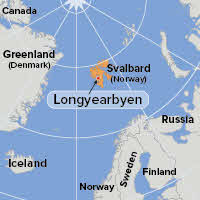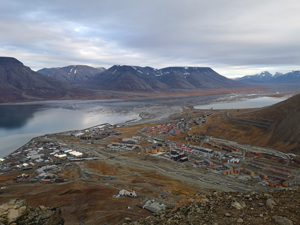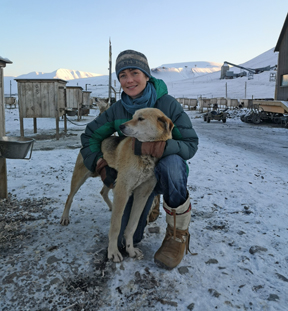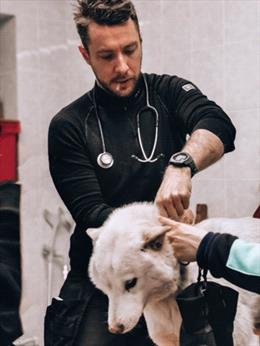Longyearbyen map

Design by Tamara Rees
Source: Adobestock/photorebelle
Whenever they venture beyond the snug confines of Longyearbyen, the world's northernmost town, Drs. Tone Heide and Hans Kristian Mjelde make sure to pack a firearm.
Situated 818 miles from the North Pole, Longyearbyen is in polar bear country. And local law dictates that residents who travel outside the settlement must be equipped with means to protect themselves.
"I don't trek far without the rifle," said Heide, 39, who also carries a flare gun for good measure. "It would be terrible being attacked by a bear and not being able to defend yourself."
Still, the possibility of being mauled by the world's biggest land predator is among the least of the two veterinarians' worries right now. A much smaller life form — SARS-CoV-2, the virus that causes COVID-19 — is producing more angst because it is harming their livelihoods.
Located at 78 degrees north latitude on Norway's Svalbard islands in the Arctic Ocean, Longyearbyen was once a coal-mining town. Now, its roughly 2,000 human inhabitants count on tourism and scientific research to keep the economy afloat. Travel restrictions imposed during the pandemic have hurt local businesses, including the commercial sled-dog yards that provide a large chunk of the veterinarians' revenue.
They are entitled to a 750,000 Norwegian krone (US$90,000) government subsidy provided to areas recognized as having difficulty generating sufficient income for veterinarians. Since Heide and Mjelde operate independently, they must split the grant for their region.
A legal quirk makes matters more difficult. Although Longyearbyen is technically part of Norway, not all Norwegian laws apply, including legislation that allows practitioners to tap certain federal grants. "The laws on the mainland don't abide up here," said Mjelde, 33. "So we have to fight more for ourselves."
A faraway place, with uncommon rules
Longyearbyen, named after the American coal miner John Munro Longyear, who set up the Arctic Coal Company in 1906, is the world's northernmost town with permanent residents. Settlements closer to the North Pole are research or meteorological outposts.
Flanked by mountains, Longyearbyen is nestled at the end of a valley and sits alongside a bay. The surrounding terrain — defined as Arctic desert due to low levels of precipitation — consists of bare rock and glaciers. Snow is more prevalent during winter, with snowmobile season starting around early December and carrying through to May.
Svalbard's polar bear population is about 3,000, according to the local government, and they have killed six humans on the islands in the past 50 years. The most recent incident occurred about a year ago when a Dutchman was killed by a bear at a campsite near Longyearbyen. Other local fauna include reindeer, Arctic foxes, seals and walruses.
Owing to its extreme location, mandatory polar-bear safeguards aren't the only unusual rules that apply. It is illegal, for instance, to bury deceased humans in Longyearbyen because of concerns they won't decompose in the frosty climate and could harbor disease.
Of more relevance to veterinarians, cats are banned in Longyearbyen out of fears they'll spread disease, such as rabies, because their movements may be harder to control than dogs, which are needed for the sled yards, in any case. There are also concerns that cats will hunt local birdlife.
Longyearbyen

Photo by Dr. Tone Heide
The temperature in Longyearbyen can fall as low as -50 F but climate change is driving a warming trend. Flanked by mountains, the town occupies terrain known as Arctic desert, characterized by bare rock and glaciers. Snow is more prevalent in winter.
The domestic cat population isn't zero, though. According to Heide and Mjelde, some cats live in nearby Barentsburg. "They're descendants of the cats that were imported before the ban in 1992," explains Heide. "So I assume it's quite an inbred group of cats."
Barentsburg, about 23 miles south of Longyearbyen, is Svalbard's second-largest settlement, and inhabited predominantly by ethnic Russians and Ukrainians. There are no roads connecting the two towns, so travelers, including pets, must come by boat, helicopter or snowmobile. "I saw a cat patient from Barentsburg today," Heide said. "It got a ride with the Russian helicopter."
Veterinary medicine in Longyearbyen: A short history
Longyearbyen hasn't exactly been accommodating to veterinarians, in part due to housing shortages that force renters onto short leases. The town's first clinic was established in 2013 by Dr. Astrid Vikaune, who managed to grow it to the point where she employed two more veterinarians at one time.
One of Vikaune's employees was Heide, who had fallen in love with the town in 2010 and 2011 while doing reindeer fieldwork. "Just 10 minutes after I arrived, I was completely in awe, because of the mountains, the lights and the rest of the incredible scenery here."
In 2017, Heide came back to Longyearbyen to work for Vikaune on a 12-month contract. Afterward, she felt like doing something different, so she tried her hand as a harbor assistant in nearby Ny-Ålesund and a cabinetmaker in Longyearbyen before returning to veterinary medicine there in 2019.
"At that point, it made more sense setting up my own practice," she said. Heide found the going tough thanks to the rental-home shortage, recalling having to move eight times in a single year. She eventually bought her own house in Longyearbyen, where she now lives with her husband and their infant daughter.
Mjelde, for his part, graduated from veterinary school in Oslo last year and went to Longyearbyen in search of work. Like Heide, he was hired by Vikaune, but soon found himself in a tricky situation: Vikaune wanted to depart Longyearbyen for family reasons, leaving the town's first clinic without a financial backer.
Dr. Tone Heide

Photo courtesy of Dr. Tone Heide
Dr. Tone Heide, pictured at a sled-dog yard, first arrived in Longyearbyen in 2010 to help with field research on reindeer. Almost immediately, she fell in love with the place. She set up a veterinary clinic there in 2019.
"I had to buy the clinic to keep my job there, or move," Mjelde said. "So I decided to buy it and start my own brand."
Mjelde acquired the business for 1.6 million krone (US$192,000) in three installments. About 30% was funded by bank loans, 30% from government grants and 40% with his own cash.
He also has bought his own accommodation in Longyearbyen, where he says an 80-square-meter (or 861-square-foot) apartment can cost more than 3 million krone (US$360,000). (Later, he moved in with his girlfriend, also a local homeowner.)
Soon after buying Vikaune out, the economic pressures presented by the pandemic forced Mjelde to make another tough call: He had to lay off the clinic's other two practitioners.
Hundreds of huskies, three horses and a few guinea pigs
Much of the veterinarians' income comes from treating dogs — though some other domesticated creatures reside in town, including guinea pigs, rabbits and three horses that live in a stable by the harbor.
Heide and Mjelde say Longyearbyen has about 1,200 dogs, roughly 80% of them residing in commercial dog yards. Those dogs, many of them huskies and Greenland dogs, pull sleds in winter and carts in summer, either for tourist treks, scientific research, fossil hunts or just for sport. The remaining 20% are private pets: either retired working dogs or all manner of other breeds, from Dalmatians to Chihuahuas.
Work in Longyearbyen can be patchy, the practitioners lament. Busier days are spent vaccinating canines for diseases such as rabies and canine distemper virus in dog yards a couple of miles out of town.
Dr. Hans Kristian Mjelde

Photo courtesy of Dr. Hans Kristian Mjelde
Dr. Hans Kristian Mjelde vaccinates a dog in Barentsburg, the second-largest settlement in the Svalbard archipelago after Longyearbyen. Mjelde also provides care for dogs on the islands of Hopen, Bjørnøya and Jan Mayen, where the Norwegian Meteorological Institute has bases. "They use the dogs for polar bear protection and alarms, as is common in these parts," he says.
Mjelde reckons he'd be about 20% busier if not for the pandemic sapping demand. And that's an improvement from 2020, when he estimates his clinic pulled in about 50% less revenue than in 2019. "Vaccinations are running their normal course, but I would say that COVID made people run at a bare minimum," he said. "In other words, they would usually only contact us in emergency cases. A lot of the dog yards decided to adopt away some of their older dogs, in favor of breeding new, younger dogs for the years to come."
Common surgical procedures include suturing bite wounds: The working dogs don't always get along, especially when bitches are in heat. Skin problems also are common, in part due to the cold temperatures; and many owners ask to have their dogs dewormed.
Although the work can be monotonous and scarce, the veterinarians must be prepared to handle a variety of scenarios. "We don't really have the chance to do referrals up here," Mjelde said. "Dogs can be sent to the mainland, say for a bigger referral, but when it comes to emergency treatment, we have to do everything ourselves."
Neither veterinarian has the resources to offer a 24/7 service, though both find it hard to resist taking after-hours calls from clients, especially during emergencies. If they don't answer a call and their clinic is closed, clients can turn up at their homes, Mjelde said.
Living on top of the world offers the veterinarians an opportunity to engage in fascinating research, whether it's assisting the Norwegian Polar Institute to study polar bears or investigating dog worms for the Norwegian Veterinary Institute.
A diverse local cuisine is provided by residents hailing from Thailand, Russia and many other parts of the world. Drinks can be enjoyed in local bars (especially so, since alcohol and tobacco in Svalbard aren't taxed) and available outdoor pursuits include hiking, skiing, snowmobile tours, hunting and fishing.
"Even though it's a small town, we have a lot of stuff going on, with plenty of opportunities to socialize since we live so close together," said Heide. "I think the social part is the main reason why I'm still in Svalbard."
To cooperate or not to cooperate?
To be sure, living in Longyearbyen has drawbacks even at the best of times. Temperatures can drop as low as -50 F and summer doesn't always bring respite from the chill: the average high during the warm season is around 45 F. (The climate is changing, though: Longyearbyen reportedly is in the fastest-warming region on Earth. Higher temperatures have been blamed for triggering avalanches that have killed two residents and destroyed more than a dozen homes.)
For much of the year, the town is either in 24-hour darkness or 24-hour light, playing havoc with circadian rhythms. "You can get cabin fever quite easily up here, being stuck on an island near the North Pole," Mjelde said.
Still, it's not easy for him or Heide to travel back to the mainland to visit family and friends. Doing so means having to temporarily shut their doors to clients.
The practitioners said they've considered cooperating. "It would be great to share the facilities, the equipment and just the experience," Heide said.
Mjelde said "there could be some opportunities" to work together, but added that he'd been through a lot keeping his clinic afloat.
Besides, both veterinarians recognize that operating independently has benefits. "From the customers' side of it, I think some competition is good," Heide said.
Their current focus seems geared to making it possible for both practices to survive. The veterinarians are monitoring lobbying efforts by the Norwegian Veterinary Association to convince Oslo to let practitioners in Longyearbyen access federal grants to fund around-the-clock care.
With more funding, each practice could expand, assuming they could find practitioners who fit with the demands of living in this unique setting.
"You need more reasons than just work to come and stay in Longyearbyen," Heide said. "I would hope that the person has an interest in nature, in experiencing the town and so on, because — say you're a super-experienced orthopedic surgeon — you're not going to get many challenging cases up here."
Challenging situations, though, do occur. Mjelde recalled an occasion when a power shortage suddenly cut the lights at a dog yard where he was working. It was pitch black, -22°F and the vaccines froze.
"Some days are better than others," he said. "But in the end, it's not normal practice up here, and you have to figure a lot of things out yourself."
That means prospective residents need to be tough, but not to an extreme, he said: "You have to roll with the punches, but you don't have to be a badass to live up here."